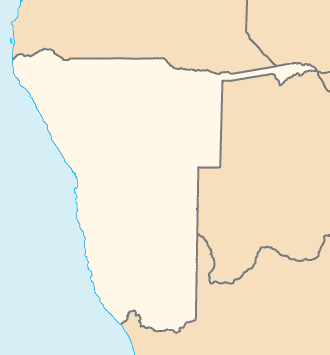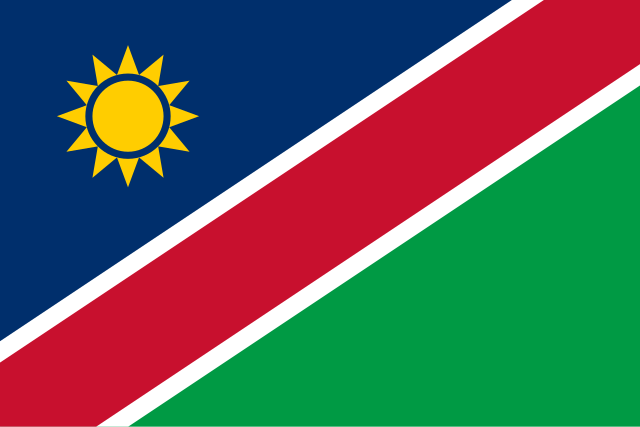Namibia Military Power Ranking 2025
MPR Rank: 145th
MPR SCORE: 199
MPR Index: 0.0443 (1.0000 is perfect)
Reverse MPR Index: 0.9057 (0.0000 is perfect)
Z Score: -0.660 (standard deviations above the mean)
Overview
Namibia ranks 145th in the 2025 Military Power Rankings. Its military, the Namibian Defence Force (NDF), is a modest but professional force focused on internal security, border defense, and regional peacekeeping operations. Formed after independence in 1990, the NDF integrates veterans of the People’s Liberation Army of Namibia (PLAN) and continues to evolve within a non-aligned defense framework, prioritizing national sovereignty and African solidarity.
Namibia's military is not designed for power projection or expeditionary warfare but plays a consistent role in supporting regional stability, particularly through the Southern African Development Community (SADC) and African Union (AU) peacekeeping deployments. The country’s geographic vastness, low population density, and stable political environment allow the NDF to focus on territorial surveillance, border patrol, and rapid domestic response.
Strengths
Namibia’s military strengths lie in its well-trained infantry, stable defense infrastructure, and regional peacekeeping reputation.
1. Peacekeeping Contributions and Regional Security Role
Namibia has participated in AU and UN peacekeeping missions, including operations in Sudan, DR Congo, and Ivory Coast.
These deployments enhance tactical readiness, interoperability, and strategic relations within Southern Africa.
2. Professional Ground Forces
The Namibian Army includes light infantry, mechanized battalions, and engineer units capable of rapid deployment across Namibia’s varied terrain.
Training emphasizes discipline, mobility, and terrain adaptability over high-tech systems.
3. Strong Civil-Military Relations
The NDF is embedded in national emergency response, border management, and disaster relief, reinforcing its domestic legitimacy.
The military works closely with police services and civilian agencies during floods, wildfires, and cross-border smuggling incidents.
4. Strategic Depth and Border Security
Namibia’s long land borders with Angola, Zambia, and Botswana necessitate strategic border deployments.
The military maintains outposts and surveillance capabilities along key border crossings and rural frontier zones.
Why Namibia Is Ranked 145th
Limited Air and Naval Capabilities
The Namibian Air Force operates a small fleet of helicopters and trainer aircraft with no modern combat aviation or radar coverage. The Navy is confined to coastal patrols, lacking blue-water capability.No Strategic Deterrent or Missile Systems
Namibia does not operate long-range artillery, air defense networks, or missile platforms, limiting its ability to deter or respond to external threats.Aging Equipment and Modest Budget
Much of Namibia’s ground equipment consists of older South African, Soviet, and Chinese vehicles, with modernization efforts slowed by fiscal constraints.No Regional Force Projection or Joint Command Infrastructure
While Namibia is active in peacekeeping, it lacks the airlift, logistics, and C4ISR systems required for independent expeditionary deployments.
Conclusion
Namibia’s military plays a critical national and regional role despite its limited size and equipment inventory. With a focus on border defense, peacekeeping, and internal stability, the NDF remains a disciplined and respected institution. Though it does not project power beyond its borders independently, Namibia’s ranking reflects its contribution to African stability, domestic security architecture, and multilateral defense diplomacy under the SADC and AU frameworks.
Military Strength and Force Projection
Active Military Personnel: 12,000 (IISS 2023)
Reserve Personnel: 2,000
Paramilitary Forces: 1,000 (Border Police, Special Forces)
Army Personnel: 10,000
Navy Personnel: 1,000
Air Force Personnel: 1,000
Ground Forces
Main Battle Tanks (MBTs): 10+ (older Soviet-era models)
Armored Fighting Vehicles (AFVs): 100+
Artillery (Towed and Self-Propelled): 40+
Air Force
Combat Aircraft: 5+ (limited)
Helicopters: 10+ (transport)
Transport Aircraft: 5+
Aircraft Breakdown:
Su-25 Ground Attack Aircraft: 3
Mi-8 Helicopters: 5 (transport)
Naval Forces
Namibia has a small naval force focused on securing its coastline and maritime borders, especially to counter illegal fishing and smuggling.
Patrol Boats: 4
Fast Attack Craft: None
Missile Capabilities
Namibia does not possess advanced missile systems or nuclear capabilities. The military's primary focus is on conventional defense and securing the country's borders, without significant capacity for force projection beyond its region.
Strategic Partnerships
Namibia has defense partnerships with regional powers such as South Africa and Angola. The country is involved in peacekeeping missions through the African Union (AU) and receives military aid and training from China and Russia. These partnerships help Namibia maintain a modest but effective defense capability, primarily focused on border protection and internal security.
Military History & Combat Experience
Namibia’s combat history is shaped by its liberation struggle, border wars, and regional peacekeeping, rather than traditional interstate warfare.
Namibian War of Independence (1966–1990):
Fought between the South West Africa People’s Organization (SWAPO) and the South African Defence Force (SADF), this protracted conflict defined the origins of modern Namibian defense. The People’s Liberation Army of Namibia (PLAN) used guerrilla warfare, cross-border raids from Angola, and ambush tactics to fight South African control. The experience formed the basis of infantry-centric doctrine and terrain awareness in today’s NDF.Border Skirmishes and Civil Tensions (1990s–2000s):
Post-independence, Namibia dealt with localized uprisings and border tensions, particularly with Caprivi separatists and illegal cross-border activities. The military conducted domestic stabilization operations, reinforcing national unity and force presence.Peacekeeping Operations (2000s–Present):
Namibia has contributed to UN and AU peacekeeping missions, especially in Sudan (UNAMID) and the DR Congo (MONUC/MONUSCO). Namibian forces have performed guard duties, patrols, logistical support, and civilian protection, gaining valuable experience in non-conventional environments.Participation in SADC Rapid Deployment Force (RDF):
Namibia is a contributor to the SADC RDF, a standby peacekeeping force for the region. Though not frequently deployed, the NDF conducts joint exercises and contingency planning, enhancing readiness for multilateral crisis response.
Namibia’s military experience reflects a blend of guerrilla heritage, civil defense mandates, and modern peacekeeping exposure, resulting in a force structured for regional stability rather than high-intensity warfare.
General Information
Demographics and Geography
Population: ~2.6 million (2024 est.)
Population Available for Military Service: ~1.1 million
Geographic Area: 824,292 km²
Land Boundaries: 4,220 km
Bordering Countries: Angola, Botswana, South Africa, Zambia
Coastline: 1,572 km
Climate: Desert and semi-arid; hot, dry conditions with variable rainfall
Terrain: High plateau, Namib Desert along coast, Kalahari Desert in east
Natural Resources: Diamonds, uranium, copper, gold, lead, zinc, natural gas, fish, hydroelectric power
Proven Oil Reserves: Small offshore discoveries (commercial viability under exploration)
Proven Natural Gas Reserves: ~1.3 trillion cubic feet (offshore Kudu gas field)
Economic Indicators
Defense Budget (2025): ~$360 million USD
Defense Budget as % of GDP: ~3.0%
GDP (PPP): ~$33 billion USD
GDP per Capita (PPP): ~$12,700
External Debt: ~$10.6 billion USD
Military Expenditure Trend (last 5 years): Gradual decline, with moderate reallocation to internal development priorities
Military Infrastructure and Readiness
Military Service Obligation: Voluntary
Primary Defense Focus: Border protection, internal stability, counter-poaching operations
Military Industry Base: Minimal; dependent on imports
Cyber/Electronic Warfare Capability: Low
Nuclear Warhead Inventory: None (non-nuclear state)
Major Military Districts / Commands: Organized under Namibian Defence Force (NDF) regional commands
Missile Inventory Highlights: Short-range anti-air and anti-tank weapons
Reservist Call-up Readiness / Timeline: Low readiness; 60–90 days
Reservist Force Size: ~10,000
Space, Intelligence, and Strategic Infrastructure
Space or Satellite Programs: None
Military Satellite Inventory: None
Intelligence Infrastructure: Namibian Central Intelligence Service (NCIS), military police
Intelligence Sharing Partnerships: Southern African Development Community (SADC), bilateral cooperation
Airports (Total): ~112 (including airstrips)
Major Military Airports: Grootfontein Air Base, Hosea Kutako International (dual-use)
Naval Power and Maritime Logistics
Merchant Marine Fleet: Minimal
Major Ports: Walvis Bay, Lüderitz
Naval Infrastructure: Small patrol fleet; Navy HQ in Walvis Bay
Naval Replenishment Capability: Very limited coastal patrol and support operations
Domestic Mobility and Infrastructure
Railway Network: ~2,600 km
Roadways: ~48,000 km
Energy and Fuel Logistics
Oil Production: None (exploratory phase)
Energy Imports: Heavily reliant on imports from South Africa and Zambia
Strategic Petroleum Reserves: Small; held at Walvis Bay terminal
Defense Production and Strategic Forces
Domestic Defense Production: None
Military Installations (Domestic): Grootfontein, Otavi, Windhoek, Walvis Bay
Military Installations (Overseas): None
Foreign Military Personnel Presence: Minimal; occasional joint training observers
Defense Alliances: SADC Standby Force, African Union
Strategic Airlift Capability: Limited; C-130 transport and helicopters
Wartime Industrial Surge Capacity: Very low
Research and Industry Support
Defense R&D Investment: None
Key Wartime Industries Beyond Defense: Mining transport, port logistics, public construction
Political and Administrative Structure
Capital: Windhoek
Founding Date: March 21, 1990 (independence from South Africa)
System of Government: Presidential representative democratic republic



